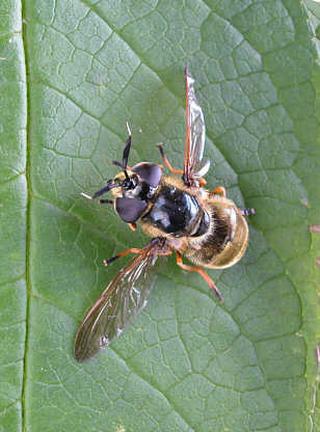 |
| Callicera aurata (photo of mounted specimen © Andy Purcell www.focusonwildlife.org.uk ) |
Worcestershire Record No. 21 April 2007 p. 9
Brett Westwood
On 10th September 2006, a warm and sunny day, I was walking along a bridleway between arable fields in open countryside at Ismere, between Stourbridge and Kidderminster. I stopped to look at a stretch of ivy blossom in the hedgerow which was buzzing with hundreds of Eristalis and some syrphid hoverflies , and noticed a wasp-like insect with prominent antennae hovering around the flowers. On closer inspection this turned out to be a hoverfly and was immediately recognisable as a Callicera species.
Its most obvious features were the long, bent antennae, tipped with white, which stood out very well against the darker ivy leaves. On closer inspection, down to a few inches at times, it had a bronzy abdomen, dusted with golden hairs, forming faint but distinct bands. The wings were long and held folded over the abdomen , slightly exceeding it in length. At times the insect fed on sunlit ivy flowers, mopping up nectar, often crawling into the foliage to feed on shaded blossoms. In flight, its unique character made it recognizable from some distance, the long antennae giving it a wasp-like appearance very different from the Eristalids around it. The insect fed around the same patch of ivy for at least two hours, long enough for me to bring a hoverfly identification guide to it!
At the time, it soon became clear that the insect was Callicera aurata , a fact later confirmed by Roger Morris, author of Hoverflies of Surrey and a key member of the national hoverfly recording scheme. The only confusion species is the much rarer Callicera spinolae, which is now apparently confined to one or two wooded East Anglian estates. Conversations I’ve had since with other entomologists seem to suggest that I’m unlikely to see another aurata in my lifetime. They’re apparently so capricious in their appearances that you’d have more chance of finding a rainbow! But the records are intriguingly scattered across the UK, and locally there have been records from Wolverhampton and Moseley, so autumn-flowering ivy is well worth a second glance wherever you live.
 |
| Callicera aurata (photo of mounted specimen © Andy Purcell www.focusonwildlife.org.uk ) |
Editor’s note
In July 2006 I exchanged a series of emails with Andrew Curran who had observed an interesting hoverfly on a teasel at Edgbaston but had been unable to obtain a picture or capture the insect. After discussion we came to the following partial but suggestive conclusion expressed in Andrew’s email:
“I am now almost certain that it was a Callicera. Admittedly no firm identification for the following reasons. I did not take note of the double bends in the antennae. The wings were naturally closed together over the abdomen at all times whereas the wings were held perpendicular to the thorax in the case of Callicera aurata by Mike Bloxham. (NB this photograph, which in included here, is of a set museum specimen so the wing position is probably misleading. Ed). I can only conclude that the probable Callicera (aurata) was on Teasel by University (Birmingham) Station (very interestingly only a few miles away from Moseley – see Bloxham 2002)) on 28 July 2006” – Andrew Curran.
The illustration is one used in Mike Bloxham’s article in Worcestershire Record No. 13.
References
| BLOXHAM M, 2002. Suburban insects in North Worcestershire (12th & 13thAugust 2002). Worcestershire Record, 13, page 27. | |
| MORRIS RKA 1998. Hoverflies of Surrey. Surrey Wildlife Trust. (there is a good illustration of a mounted specimen in this book) |
RECORDER 3.3 is positively lyrical about Callicera aurata as follows: Designation Red Data Book 3. A hoverfly usually found in ancient forests with over-mature and senescent trees especially Fagus (beech) and Quercus (oak) Adults are primarily arboreal rarely descend to feed at flowers or to drink at streams. Occasionally found at great distances from apparently suitable breeding localities (eg a recent record in a suburban garden in Wolverhampton). Larvae have been found in rot holes high (18 m) in an old beech tree in ancient forest. In Great Britain mainly recorded from ancient forest in southern central England (especially the New Forest) but there are a scatter of records for SW England, Wales and the Midlands, and two records from central Scotland. In Europe the situation is not clear because of confusion with C. aenea, but there are records from Norway, France, south to the Mediterranean and eastwards through central and southern Europe to Turkey. Definitely a species to look for – flies between June and August.
| WBRC Home | Worcs Record Listing by Issue | Worcs Record Listing by Subject |